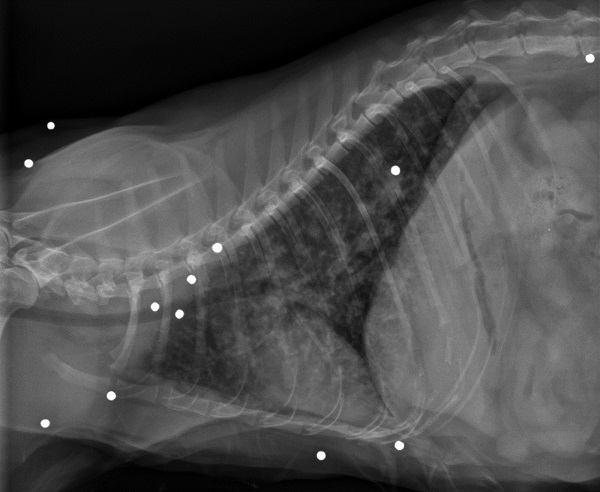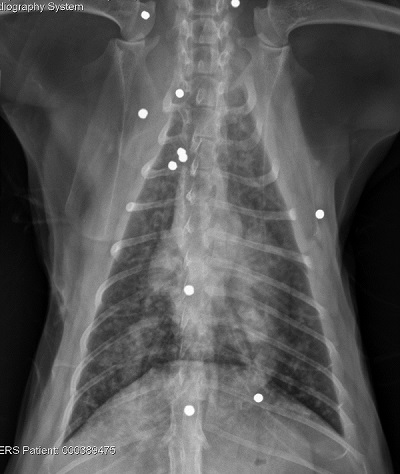Dexter
Domestic Shorthair
Radiographic Report
Radiographic Interpretation: There are numerous subcutaneous and at least one intrapulmonary metallic pellets (likely the result of a shotgun blast). However, there are no signs of acute trauma (no pleural effusion; no fractures). The pellets are an incidental finding and there is no indication these are contributing to the respiratory signs. The lungs are markedly increased in density. The distribution of infiltrates is generalized but may be more intense caudal-dorsally. The densities appear to be heavy unstructured interstitial densities with some ill-defined nodularity also evident. The most significant diagnostic feature relates to markedly dilated caudal pulmonary arteries. These are outlined in the second VD (with arrows). The left caudal artery is particularly dilated.
Discussion: The pellets are an incidental finding and there is no indication these are contributing to the respiratory signs. There is no pleural effusion but pulmonary densities are grossly abnormal. Since the pattern/distribution is diffuse, this would not be considered a typical bronchopneumonia. Atypical pneumonia (e.g. from Mycoplasma) could certainly look this way, and it should be remembered that diffuse pneumonia in cats often appears interstitial to nodular. Pulmonary neoplasia is another differential as the appearance in cats is more variable than that of dogs. Chronic lungworm disease with pulmonary parenchymal reaction would be another possibility (Aleurostrongylosis). But the markedly dilated pulmonary arteries indicate this cat has pulmonary hypertension and the radiographic diagnosis is feline heartworm disease with “HARD” (heartworm associated respiratory disease) until proven otherwise. Heartworm antibody test (for exposure), antigen test (for infection), and 2D echocardiogram of the pulmonary arteries are indicated. If negative for dirofilariasis, an endobronchial washing would be recommended for cytology and culture (including Mycoplasma) and additional serological testing (toxoplasmosis, FeLV, FIV). This cat was infected with heartworms.
Treatment/Management: There is no definitive treatment for dirofilariasis in cats, but doxycycline, prednisolone, and monthly heartworm preventative are typical management strategies for feline infection with heartworm disease. Following stabilization and a course of medical treatment, referral for catheter based removal of adult worms also can be considered, but is uncommonly performed unless the cat is medically refractory to treatment. Since most cats harbor only 1-3 adult worms and often these are located partially within the right heart, there is potential for removal with a snare or foceps device under fluoroscopic guidance.
Clinical History
Dexter is an unknown aged male neutered DSH cat who was adopted by new owner about 5 months ago.
History of rapid breathing, chronic coughing and occasional vomiting. Exam indicates loud bronchial sounds and increased respiratory effort.

